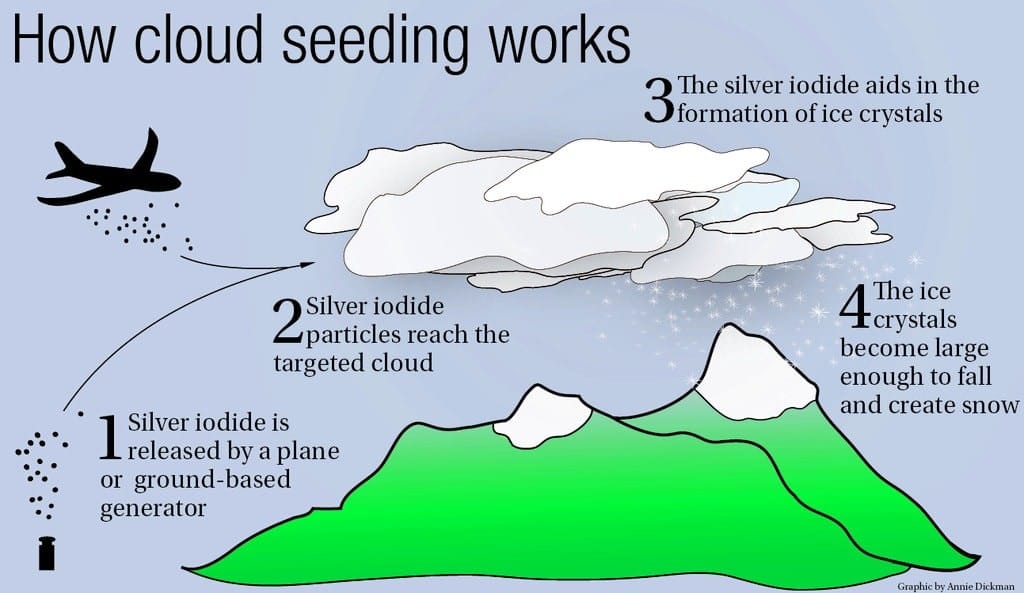Introduction
Water is the essence of life, yet millions around the globe face water shortages due to erratic rainfall patterns, population growth, and climate change. As natural water sources dry up and traditional methods of water management struggle to meet the demand, scientists and policymakers are turning to innovative technologies. One such technolgy is artificial rain, also known as cloud seeding, which manipulates atmospheric processes to produce rainfall. This article provides a comprehensive overview of artificial rain, exploring its concept, technology, process, applications, benefits, challenges, and notable projects worldwide.
What is Artificial Rain?
Artificial rain refers to the deliberate stimulation of precipitation in clouds using technological interventions. The process involves dispersing substances into the atmosphere to encourage water vapor in clouds to condense and fall as rain.
The idea of modifying weather is not new; it dates back to the 1940s when scientists first experimented with inducing rainfall. Today, artificial rain is widely researched and applied, especially in arid and semi-arid regions where water scarcity poses a significant challenge.
Artificial rain serves several purposes: increasing water availability for agriculture, replenishing reservoirs, mitigating forest fires, and even combating urban pollution. While it cannot solve all water scarcity issues, it offers a promising supplementary tool for managing water resources.
The Technology Behind
Artificial Rain
Artificial rain primarily utilizes cloud seeding technology to induce precipitation. This method relies on the scientific principle of providing condensation nuclei to clouds, which accelerates the formation of water droplets.
Key Chemicals Used --->>>
- Silver Iodide (AgI):
- The most commonly used seeding agent, silver iodide mimics ice crystals, encouraging water vapor to freeze and grow.
- Sodium Chloride (Salt):
- Promotes the coalescence of water droplets by enhancing the condensation process.
- Dry Ice (Solid Carbon Dioxide):
- Lowers the cloud temperature, encouraging ice crystal formation in supercooled water clouds.
- Hygroscopic Substances:
- Materials like calcium chloride are used to attract and absorb moisture in warm clouds.
Methods of Dispersion --->>>
- Aerial Seeding:
- Aircraft equipped with dispersal systems release chemicals directly into the target cloud formations.
- Ground-Based Generators:
- Cannons or generators on the ground emit chemicals into the atmosphere, carried upwards by wind currents.
- Drones:
- The latest advancements involve using unmanned drones for precise and cost-effective cloud seeding.
Role of Weather Prediction Technology--->>>
Accurate weather forecasting is crucial for the success of artificial rain. Meteorologists use satellite imagery, radar systems, and advanced computer models to identify suitable clouds for seeding and predict their behavior.
Process of Artificial Rain
The process of artificial rain involves several key steps:
- Cloud Selection:
- Meteorologists identify clouds with sufficient moisture content, as cloud seeding cannot create rain from completely dry conditions.
- Chemical Dispersal:
- Once suitable clouds are identified, dispersal agents such as silver iodide or salt are released into the atmosphere using aircraft, drones, or ground-based systems.
- Nucleation and Condensation:
- The introduced chemicals serve as nuclei around which water vapor condenses. This leads to the formation of larger water droplets or ice crystals within the cloud.
- Growth and Precipitation:
- As the water droplets grow in size, they eventually become heavy enough to overcome updrafts and fall to the ground as rain.
Usage of Artificial Rain
Artificial rain has diverse applications across various sectors, making it a versatile tool in water and environmental management.
1. Agriculture
One of the primary uses of artificial rain is to support agricultural activities. Drought-prone regions can benefit from induced rainfall to ensure irrigation and boost crop yields.
2. Reservoir Replenishment
Artificial rain can help refill dams, lakes, and reservoirs that supply drinking water to urban and rural communities. This is particularly useful in regions experiencing prolonged dry seasons.
3. Forest Fire Mitigation
In areas prone to wildfires, artificial rain can be used to enhance moisture levels in vegetation, reducing the risk of fires spreading uncontrollably.
4. Pollution Control
Urban areas suffering from high levels of air pollution can use artificial rain to cleanse the atmosphere. Rain washes away airborne particles and reduces smog, improving air quality.
5. Industrial Applications
Industries that depend heavily on water, such as mining and power generation, can benefit from artificial rain to ensure a consistent water supply.
Benefits of Artificial Rain
The advantages of artificial rain extend beyond immediate water supply needs, offering environmental, economic, and social benefits.
1. Alleviates Water Scarcity
By inducing rainfall, artificial rain helps to address water shortages, especially in drought-affected regions.
2. Enhances Agricultural Productivity
Consistent rainfall can stabilize food production, ensuring food security for communities dependent on rain-fed agriculture.
3. Mitigates Wildfires
Artificial rain can act as a preventive measure against wildfires, protecting forests, wildlife, and nearby human settlements.
4. Improves Air Quality
Rain induced in polluted urban areas can wash away harmful particulate matter, making the air cleaner and healthier to breathe.
5. Supports Economic Development
Industries reliant on water resources can sustain operations, leading to economic growth and job creation.
Challenges of Artificial Rain
Despite its benefits, artificial rain faces significant challenges that limit its effectiveness and adoption.
1. Environmental Concerns
The chemicals used in cloud seeding, particularly silver iodide, raise concerns about potential long-term environmental impacts. While studies show minimal harm, the accumulation of these substances in ecosystems warrants further research.
2. Dependency on Existing Clouds
Artificial rain cannot create clouds; it can only enhance precipitation from clouds already present. This limitation reduces its effectiveness in extremely arid regions.
3. High Costs
Cloud seeding operations require specialized equipment, trained personnel, and precise meteorological data, making it an expensive solution.
4. Weather Manipulation Ethics
There are ethical and legal concerns about manipulating weather patterns, especially when it could affect neighboring regions or cross international borders.
5. Unpredictable Results
Success rates for cloud seeding vary, as factors like wind patterns and atmospheric conditions influence the outcome.
Notable Companies and Projects
1. China’s Weather Modification Program
China operates one of the largest artificial rain programs in the world. The country has used cloud seeding extensively to combat droughts and ensure favorable weather conditions for large-scale events like the 2008 Beijing Olympics.
2. United Arab Emirates (UAE)
The UAE has pioneered the use of drones to electrify clouds, encouraging rain formation in its desert climate. Their investments in weather modification research have positioned the country as a leader in this technology.
3. India’s Cloud Seeding Initiatives
Indian states like Karnataka and Maharashtra have conducted cloud seeding projects to address water scarcity and support agriculture.
4. United States Bureau of Reclamation
In the United States, cloud seeding is used in states like California and Colorado to enhance water supplies for agricultural and urban use.
5. Thailand’s Royal Rainmaking Project
Initiated by King Bhumibol Adulyadej, Thailand’s rainmaking project has been a successful example of cloud seeding to tackle drought and water shortages.
Conclusion
Artificial rain, or cloud seeding, represents a groundbreaking approach to addressing water scarcity and managing environmental challenges. Its ability to enhance precipitation provides relief to drought-stricken regions, supports agriculture, mitigates wildfires, and reduces pollution. However, the technology is not without limitations, including environmental concerns, high costs, and ethical questions.
As the demand for water continues to rise, research and development in artificial rain technology must focus on improving efficiency, reducing costs, and addressing environmental impacts. With advancements in meteorology and cloud-seeding methods, artificial rain could play a pivotal role in ensuring a sustainable future for humanity. By harnessing the power of science, we can turn the dream of controlling the weather into a tangible reality, alleviating water crises and fostering resilience in the face of climate change.
(Click notification ![]() for more updates)
for more updates)

